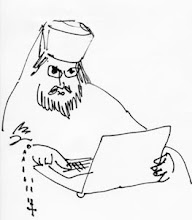
“And the Word became flesh and dwelt among us, and we beheld His glory, the glory as of the only begotten of the Father, full of grace and truth (John 1: 14).”
Our Lord Jesus Christ tells us that He is “the Alpha and the Omega, the Beginning and the End”; it is Christ “Who is and Who was and Who is to come, the Almighty” (Revelation 1:8). Accordingly, all Orthodox theology begins with Christ and finds its completion in Christ; it is “Christocentric,” that is, centered on the Person of Christ, Who reveals to us the Father, and to Whom we are lead by the Holy Spirit.
Jesus Christ, the Son of God, became incarnate; that is, He took on flesh, becoming fully human while remaining fully God. Precisely because He took on material form, He can be depicted in material form – and this is the essential foundation of the theology of the icon. In other words, because God became man, we can depict Him as a man. Jews and Muslims strictly forbid any representation of God precisely because they do not believe that God has ever taken human or material form. We Christians, however, by venerating icons of Christ, confess our belief that Christ is indeed the God-Man, the Son of God incarnate.
We do not, however, venerate only icons of Christ: we also venerate icons of the Mother of God, of angels, and of saints. Our English word “icon” comes from the Greek word “eikon,” which can be translated as either “icon” or “image.” Our Lord Jesus Christ is the foremost Icon of God. Saint Paul writes that Christ “is the image [icon] of the invisible God” (Colossians 1:15). Material creation, too, can be seen as an “icon.” It is this word that is used when it is said that human beings were created in the “image [icon] and likeness of God” (Genesis 1:26-27). As such, all human beings are “icons” of God, and above all those who have attained holiness in this life. Saint John of Damascus, one of the greatest defenders of the veneration of icons, writes: “But since some find fault with us for venerating and honoring the image of our Savior and that of our Lady, and those, too, of the rest of the saints and servants of Christ, let them remember that in the beginning God created man after His own image. On what grounds, then, do we show reverence to each other unless because we are made after God's image?” (Exact Exposition of the Orthodox Faith, 4.16).
By venerating icons of the Theotokos, of the holy angels, and of the saints, we are in fact giving glory to God: for He is the source of their holiness. Saint John of Damascus writes: “For the honor that we give to her [the Theotokos] is referred to Him Who was made of her incarnate. And similarly also the brave acts of holy men stir us up to be brave and to emulate and imitate their valor and to glorify God. For as we said, the honor that is given to the best of fellow servants is a proof of good will towards our common Lady and the honor rendered to the image passes over to the prototype” (Exact Exposition of the Orthodox Faith, 4.16). That is, by honoring the saints, we show love to God and to His holy Mother, whom they served. Moreover, when bowing down and kissing an icon, we are not venerating paint and wood, but rather the Person or persons depicted; that is, venerating an icon of the Theotokos, the honor we pay to the icon passes over to its prototype (the first model), that is, to the Theotokos herself. We likewise venerate the Gospel book, the cross, relics, the right hand of bishops and priests, and other material items, for the Son of God sanctified all of creation by His Incarnation, filling it with grace and divine energy. All of these can be considered icons, inasmuch as they are material items that point towards God and are filled with holiness.
The veneration of the Theotokos is an essential element of our confession that Jesus Christ is the Son of God. Saint John of Damascus writes: “It is with justice and truth that we call holy Mary the Theotokos; for this name embraces the whole mystery of the Economy [divine plan] of salvation” (Exact Exposition of the Orthodox Faith 3.12). That is, the word “Theotokos” sums up all our theology: it is a confession that Jesus Christ is God Incarnate. All icons of the Mother of God are holy, and by venerating any one of them we thereby venerate the Theotokos herself. Certain wonder-working icons, however, have become special sources of grace and healing, and therefore worthy of special veneration. The Kursk-Root Icon is one such icon. Bowing down before this icon, we should remember that every time we kiss it we are thereby confessing our belief in Christ as the God-Man and of His holy Mother as the vessel by which He took on human flesh, thereby granting us salvation.









No comments:
Post a Comment